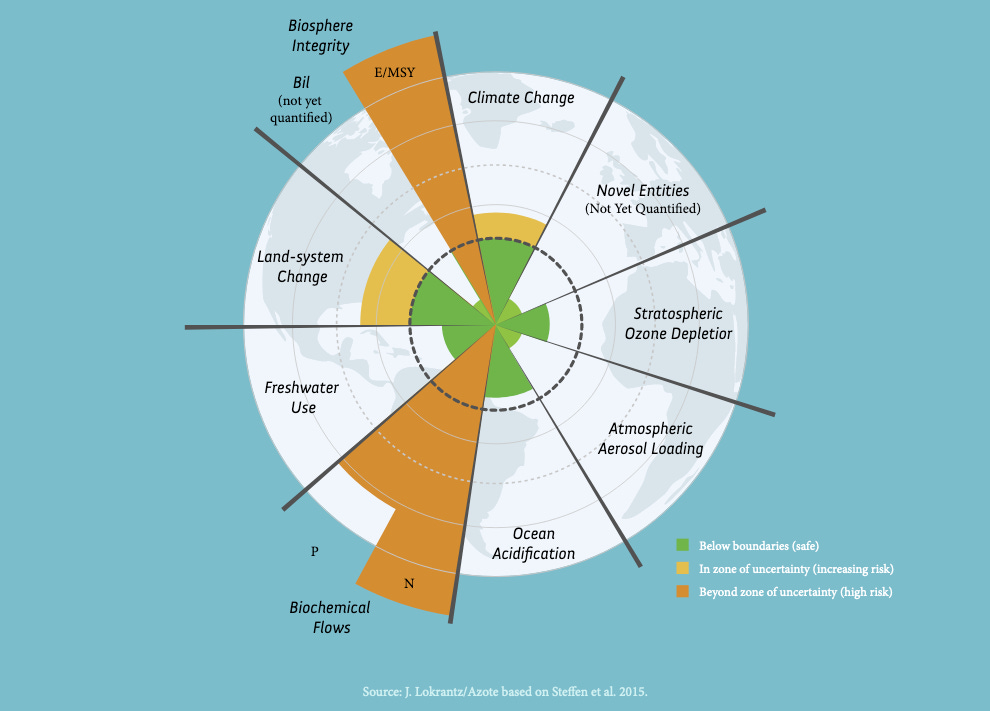Party like it's 2045?
A newsletter about food systems, climate change and everything connected to them
For more than three decades now, the “Slow Food” movement has encouraged us not just to enjoy food but also to savour and appreciate it, with a focus on seasonality and locality of the produce. The movement originated in Italy - of course!!!! - in 1989 in response to the growth of fast food and other changes around food systems.
Well, there is now a push for a “Long Food” movement, where civil society actors working on food issues take a longer-term view to reverse many of the problems ailing food systems today, from growing greenhouse gas emissions to rising hunger and obesity.
The International Panel of Experts on Sustainable Food Systems (IPES-Food) and the ETC Group (the Action Group on Erosion, Technology and Concentration) are calling for such a movement in a report published on Mar 30.
“While many groups are already working together for sustainable and equitable food systems, they are rarely able to plan more than 2 or 3 years ahead. But food systems are changing at a dizzying speed,” Nick Jacobs, director at IPES-Food and one of the lead authors, told me in an e-mail.
“Today’s e-commerce platforms and asset management firms will be tomorrow’s agri-food giants. We can’t afford to play catch-up. We need to start thinking 5, 10 and even 20 years ahead. We must be ready for shocks on the horizon. That’s why we need a Long Food Movement,” he added.
You can find the 176 page report here or if you prefer a shorter, bite-sized version, there’s also the 12-page Executive Summary and an even shorter (2 pages) FAQ.
It is actually worth reading the full report if you’re keen on this topic. I’d suggest skipping Section 2 though, unless you work for a civil society organisation.
Red Pill or Blue Pill?
The authors believe a revolution is coming - they pointed to how four of the nine Planetary Boundaries the world should live within have already been crossed - but asked, what type of revolution will it be?
So they look at what food systems could look like by 2045 under two broad scenarios.
A 4th industrial revolution from the perspective of agribusiness would be “all about digital data and DNA, artificial intelligence and machine learning, sensors and hyperspectral imaging attached to robots, drones, and satellites all backed up in clouds”, said Pat Mooney, lead author of the report.
In real life, “this could mean the mass abandonment of 300 million farms, the forced migration of well over 1 billion people, the dismantling of diversified food webs that sustain 70% of the world’s population, and surrendering the food security of billions of people to untested technologies managed by for-profit companies with no serious skin in the game,” he wrote in the Preface.
Alternatively, farmers, indigenous communities, fisherfolk and right groups could take political and legal steps that can reduce “the industrial food chain’s horrendous health and environmental damages, and shifting unproductive or counter-productive funding flows towards territorial markets and agroecology”.
This could reduce GHG emissions by an estimated 75%, he said.
Scenario 1 - “Agribusiness-as-Usual”*
The authors identified four overlapping domains where “highly disruptive innovations” could become more prevalent over the next 25 years - digitalisation, automation, molecular technologies, and nature modification, forming the backronym DAMN (Ha!).
These will take both risks and people out of food systems - for example, by letting AI manage the farm and nudge consumer behaviour, backing geoengineering and/or making protein in petri-dishes.
These technologies would drive further corporate consolidation which in turn would create new agri-food giants in an industry that is already highly concentrated, they said.
These new agri-food giants are “biodigital mega-corporations, data platforms, and private equity firms” who will take land, resources and data from many low and middle-income countries, and these businesses and powerful governments will control resources - land, ocean, etc - and food supplies in vast swathes of the world.
Data harvested from online activities would be combined with metadata generated from digital wallets, automated food services and other everyday activities, allowing for the tracking and micro-targeting of people to nudge their eating habits.
(*If this all sounds quite disturbing, well, I think that’s the whole point.)
Scenario 2 - “Civil Society as Unusual”**
But.. what could food systems in 2045 look like if civil society collaborate more? Not just among those working on “food sovereignty” but with folks demanding racial justice, equal healthcare and environmental action?
So food sovereignty refers to communities’ right to healthy and culturally appropriate food and control of their own food and agricultural systems.
Systematic cross collaboration and long-term planning could lead to more diverse crops, fairer pay to workers across the whole production system, and an emphasis on agroecology where ecologically-friendly methods are used to produce food.
“By the 2040s, famine, hunger, malnutrition, poor health, and environmental degradation are criminal violations that can be brought before the Human Rights Council (or a restructured International Criminal Court),” it said.
“By 2045… Farmers and social movements find common cause in their opposition to novel meat and dairy mimics and succeed in preventing mass rollout of these products onto global markets.”
The opposition to alternative proteins seems to stem mostly from concerns that existing conglomerates would swallow start-ups and maintain their monopoly.
The movement also pushes for reform of the three Rome-based U.N. food agencies. These are
the World Food Programme, best known for providing food assistance in emergency situations and the 2020 Nobel laureate;
the Food and Agriculture Organization, a technical agency working to improve global food security;
and the International Fund for Agricultural Development, a financial institution focused on small scale farmers in developing countries.
Oh yeah, all of the above might also shift the $720 billion worth of annual subsidies that currently go to commodities to producing food that is healthy and environmentally sustainable.
(** If this all sounds utopian, well, I think that’s also the point.)
Purple Pill?
My take is that the reality in 2045 would be somewhere in between.
While I have a lot of sympathy and feel solidarity with the food movements - I grew up in Myanmar after all, where we publicly praise farmers for their critical role but in real life keep them destitute - I am also a consumer myself and have huge doubts that 80% of the population in rich and high-meat consuming countries will become flexitarians without plant-based and cell-based meats.
There are definitely concerns around what these alternative proteins could do to food cultures - this piece by Hester van Hensbergen in Vittles is one of the best writings on this subject and while you’re at it, I do urge you to subscribe to that newsletter - but I also see their value, particularly if they have been produced in a sustainable, environmentally-friendly manner.
Likewise, while reforms are much-needed in a lot of the U.N. agencies, not just the food-related ones, I just do not see it happening. There is little incentive at the moment for the big, powerful nations that hold sway to give up any of their leverage. I’d be very happy to be proven wrong of course!
The authors did say “this report should be a provocation not a prescription” so that’s probably why the two scenarios seem so black and white, and they were quick to point out that they aren’t against ALL technologies or ALL businesses.
“Our concern about some of the so-called “climate-smart” technologies is primarily around who owns and controls these multi-industry platforms, and whether the development and deployment of untested technologies diverts resources or disrupts the ground-proofed, decentralized, technologies already in progress?”, Pat told me in an e-mail.
“We are, quite frankly, concerned that mega-corporations are too busy buying up truly innovative enterprises and thwarting the creativity of co-ops and other companies better connected to their communities and ecosystems.”
Climate change has already cut farm productivity
There have been a lot of studies on how climate change will affect agriculture in the future and how agriculture could worsen climate change - ahhh… the unhappy marriage (spoiler: they didn’t) - but not a lot on climate’s historical impact on food production.
Well, a Cornell-led study that came out yesterday shows the whopping scale of the cost of climate change - global farm productivity is 21% lower than it could have been if there had been no climate change.
“This is the equivalent of losing about seven years of farm productivity increases since the 1960s,” the authors said.
The paper also said the effect is substantially more severe in warmer regions such as Africa and Latin America and the Caribbean.
For example, the reduction was 34% in Africa, 30% in Near East and North Africa and nearly 26% in Latin America and the Caribbean. Meanwhile, cooler regions like North America and Europe and Central Asia saw much fewer losses, at 12.5% and 7.1% respectively.
Researchers said they were worried whether some countries may have influenced their findings, so they excluded large countries - China, the U.S., India, Brazil - as well as the 10% coldest or hottest countries, or the 10% or 20% smallest countries by average agricultural revenue. But their baseline findings remained the same.
"Most people perceive climate change as a distant problem," Ariel Ortiz-Bobea, lead author and associate professor at Cornell, said in a press release. “But this is something that is already having an effect.”
I spoke to Ariel in my article last November about how family farmers are already struggling to keep up with a warming world.
The paper, published in Nature Climate Change, is behind a paywall - but it is also super technical (yes, I’ve read it) - so perhaps read this short story in the Cornell Chronicle or watch the video instead?
As always, have a great weekend! Please feel free to share this post and send tips and thoughts on twitter @thinink, to my LinkedIn page or via e-mail thin@thin-ink.net.






